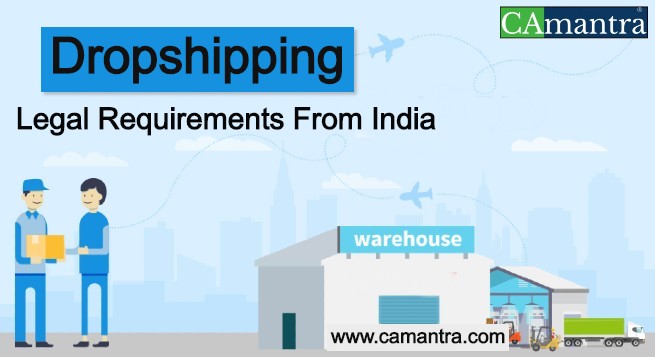Drop-shipping is a kind of business where the products to be sold from the third party and are not kept in the store, the products are purchased from the 3rd party and are directly shipped to the customer. In other words, Dropshipping is a form of a retail method where you don’t keep products in stock as inventory. In dropshipping you need to work according to the agreement between you and wholesaler supplier, wholesale supplier stock its own inventory and you need to send the customer orders and shipment details to the wholesaler and they will ship the Products directly to the customer.
International drop-shipping is where the customers and the suppliers are both based outside of India. In international drop-shipping, a person in India take orders from the customers who are based outside of India and then pass those orders to suppliers who are also based outside of India.
Is drop-shipping legal?
Yes, drop-shipping is legal. It is work as a model of order fulfillment where the retailer handles sales & supplier handles shipping.
However, there are many confusion and misconception about this business. The reality that saw with strangers’ problems is the following.
- Get licenses & trade mark
- Taxes Management
- Selling counterfeit products
- Not responding to customers
- Store are getting banned
What is the Dropshipping Legal requirement from India?
Depending on where you are operating your e-Commerce business from there can be either no legal requirements to fulfill or a variety of dropshipping legal issues. That’s the state of the e-Commerce industry currently.
While some nations promote, innovate, and facilitate the e-Commerce industry, others, tend to limit the growth of e-Commerce business with stern legal requirements. So, keep in mind that legal issues are a territorial thing.
- GST number
When products are sold outside India then the dropshipper need to charge GST in normal manner from the merchant. It will be an export sale for the merchant and he/she has option either file LUT (Letter of Undertaking) and sell without GST or he/she can pay IGST at time of sale and then apply for refund afterwards.
While the dropshipper is invoicing to the merchant, he/she can take benefit of Notification no. 40/2017 – Central Tax (Rate) and pay CGST and SGST at rate of 0.05% each or 0.1% IGST, as applicable. This benefit is subject to few conditions as mentioned in the notification.
2. Current account
For starting drop shipping business, you also need to open a new current account.
3. Import/export code [IEC]:
The IEC is required for persons exporting goods and services from India.
Why Choose Dropshipping?
- Low Capital is required
- Easy to get Start
- No Inventory Needed
- Packing and shipping the product
- Flexible Location
- Wide Selection of product
How to Start a Dropshipping?
Below are the step by step guidelines to start a Dropshipping Business.
Step 1: Choose a Supplier
From a millions of suppliers, choosing that one seller for your store is a difficult one. You need to spent ample amount of time to choosing a supplier for you because it will decide the growth of your business. If this process goes wrong, there’ll be no point regretting later. Your supplier should be trustworthy since mostly you won’t be meeting them every day as your employees and so you can’t monitor their activities much.
To choose your supplier, pay attention to these points:
- The supplier should manufacture the products too. It should not happen that the supplier himself/herself uses some 3rd party manufacturer’s services. It will be a long chain then which will be very tough for you to track. In case your supplier is not manufacturing the products, ask for their distributors and try to connect with them.
- Study the margin of profit that you can make with the suppliers. Since you’re just starting up or so you need to look at profits first. Considering the prices quoted by your suppliers and set your own prices keeping a healthy margin on all products.
- Check the delivery time your supplier promises. In today’s competitive market, you need to provide a fast product delivery service to the customers. In the dropshipping business, you’re completely dependent upon the supplier for the shipping also.
- If your supplier provides white-label products for your customers, White-label products refer to the products which will be manufactured & packaged under your brand name. At this point the customer will expect the product to be coming from your store with the particulars of your brand only.
- Your supplier can charge you in a no. of ways. They may ask you for a 1 time setup fee in the beginning and then per order, which tells that the supplier is trustworthy. They can go for a fixed monthly subscription.
Step 2: Decide Your Products to Sell
There is a reason that choosing the products should not be your Step 1. You need to choose the products which are high in demand because if you choose perfect products according to you but cannot find good suppliers in India then it will be the waste of time and money both.
So, after fix your supplier, browse their products and talk to them to discover about the best-selling products they have. Do some research as per the market and you can also take good ideas and suggestion from top level website like Amazon and many more. Refer these sites and get an idea about the product and the market trend.
Step 3: Get your GSTIN
If you are a registered company, provide your GSTIN to the supplier for all the transactions so that you can claim the ITC (Input Tax Credit) later. But, if you are not a company, then you can easily do the dropshipping business as an individual.
Clarify the GST requirements before starting up with any supplier to stay guarded from any legal issues in future.
Step 4: Create a Website for Your Store
You need to showcase your products to your customers and for doing this you need to buy a domain name and create a website for your store.
Provide all the modes of payment that you can and keep your technical side strong to manage your store since that is the only thing you have in your hand in drop-shipping business.
Step 5: List your products and market
When you do listing of the products on your store, try sharing all the required and relevant details of the products with the customers. Ask your seller for various product images to increase options and chances of selling the products.

